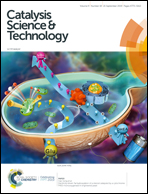Understanding trends in methane oxidation to formaldehyde: statistical analysis of literature data and based hereon experiments†
Abstract
A regression tree analysis of about 300 literature data sets on selective oxidation of methane to methanol/formaldehyde was applied to identify fundamentals affecting catalyst performance and being relevant for tailored catalyst design. According to this analysis, the kind of catalytically active metal in metal oxide species does not play a significant role in both activity and product selectivity. Such apparent unpredictability was explained by the fact that the support also affects the selectivity thus hiding the effect of supported metal oxide. To minimise the support contribution, we have initially screened various bare supports for their activity and selectivity. SiC was identified as the most inert material in the target reaction even in comparison with SiO2. A series of SiC-based catalysts with supported VOx, MoOx, FeOx or CuOx species were prepared and tested for elucidating the effects of the kind of active metal, its surface density and temperature on formaldehyde selectivity. We established that the Allen electronegativity of the active metal can be used as a descriptor for the latter catalyst property. The electronegativity seems to correlate with the overall activation energy of methane conversion thus suggesting the importance of electron transitions for catalyst functioning.



 Please wait while we load your content...
Please wait while we load your content...